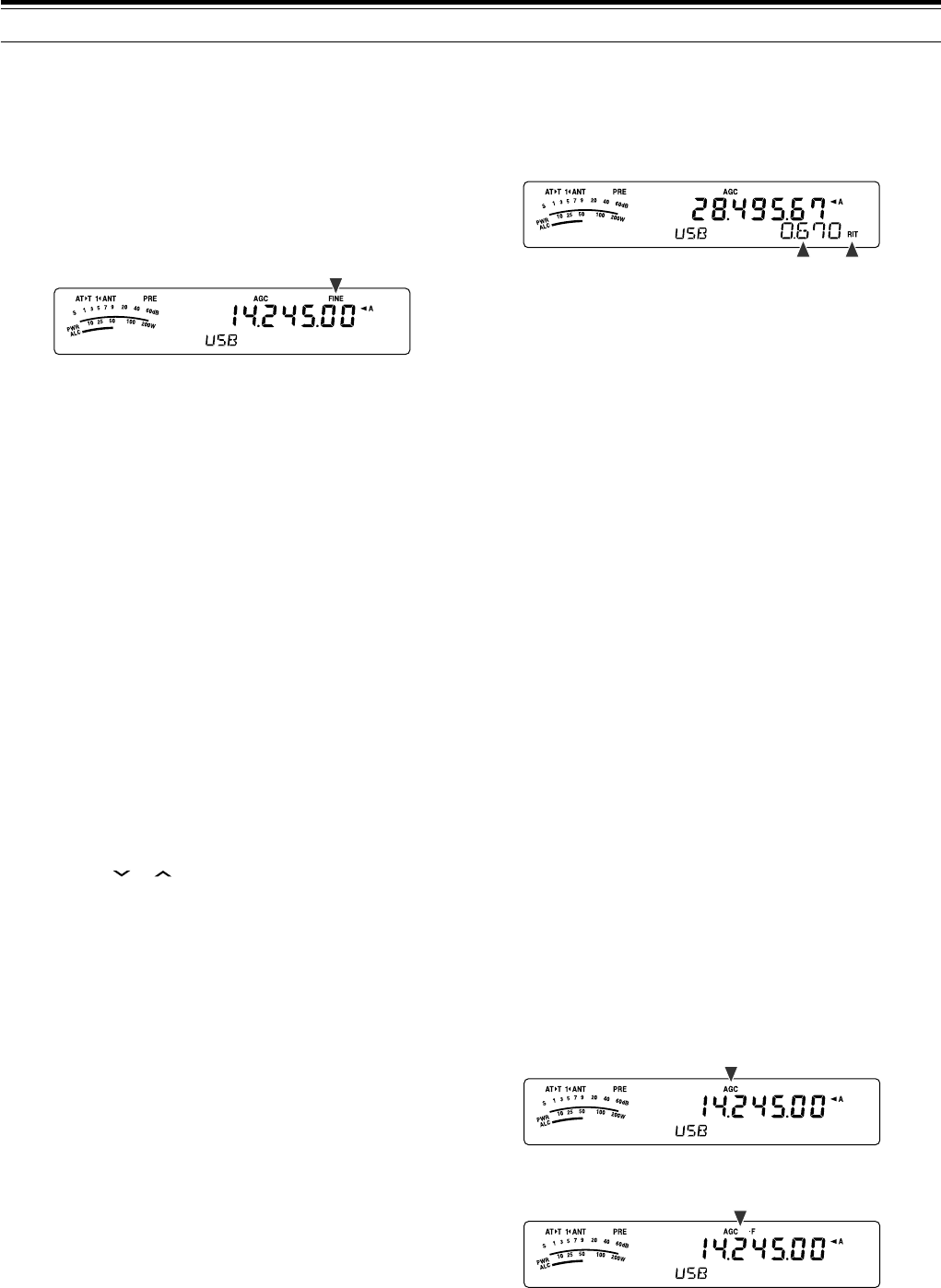
35
8 COMMUNICATING AIDS
■ Fine Tuning
The default frequency step size when turning the
Tuning control to change the frequency is 10 Hz
for SSB, CW, and FSK modes, and 100 Hz for FM
and AM modes. However, you can change the
frequency step size to 1 Hz for SSB, CW, and FSK
modes, and 10 Hz for FM and AM modes.
1 Press [FINE/ STEP].
• “FINE” appears.
2 Turn the Tuning control to select the exact
frequency.
3 To quit the function, press [FINE/ STEP] again.
• “FINE” disappears.
■ Tuning control adjustment rate
The default Tuning control adjustment rate is 500.
This represents the number of pulses the Tuning
control generates in a complete revolution. Each
pulse changes the tuning frequency based on the
current frequency step size (the frequency step
size for the Tuning control is 10 Hz for SSB/ CW/
FSK mode and 100 Hz for AM/ FM mode). For
example, in SSB mode the frequency step size is
10 Hz, so the frequency would change by
5,000 Hz in a complete revolution of the Tuning
control. The adjustment rate of the Tuning control
can be lowered to 250 pulses per revolution or
increased to 1000 pulses per revolution.
1 Press [MENU/ F.LOCK].
2 Turn the MULTI control to select Menu No. 03.
3 Press [ ]/ [ ] to select “250”, “500” (default),
or “1000”.
4 Press [MENU/ F.LOCK] to store the setting
and exit Menu mode.
■ Equalizing VFO Frequencies (A=B)
This function allows you to copy the frequency and
modulation mode of the active VFO to the inactive
VFO.
1 Select the frequency and mode on VFO A or
VFO B.
2 Press [A=B/ SPLIT].
• The frequency and mode selected in step 1
are duplicated to the inactive VFO.
3 Press [A/B / M/V] to confirm that the frequency
was copied to other VFO.
RIT (RECEIVE INCREMENTAL TUNING)
RIT provides the ability to change your reception
frequency by ±9.99 kHz in steps of 10 Hz without
changing your transmission frequency. If the Fine
Tuning ([FINE/ STEP]) function is ON, the frequency
step size becomes 1 Hz. RIT works equally well with
all modulation modes and while using VFO or
Memory Recall mode.
1 Press [RIT].
• “RIT” and the RIT offset appear.
2 If required, press [CL] to reset the RIT offset to 0.
3 Turn the RIT/ XIT control to change your reception
frequency.
4 To turn RIT OFF, press [RIT].
• The reception frequency is returned to the
frequency that was selected prior to step 1.
Note:
When storing the frequency in a Memory channel with the RIT
function ON, the RIT offset frequency is added or subtracted to/ from
the VFO frequency. The calculated data is then stored in the Memory
channel.
AGC (AUTOMATIC GAIN CONTROL)
When using a mode other than FM, AGC selects the
time constant for the Automatic Gain Control circuit.
Selecting a slow time constant will cause the receiver
gain and S-meter readings to react slowly to large
input changes. A fast time constant causes the
receiver gain and the S-meter to react quickly to
changes in the input signal. A fast AGC setting is
particularly useful in the following situations:
•Tuning rapidly
• Receiving weak signals
• Receiving high-speed CW
For your convenience, the following default AGC time
constant has already been programmed.
SSB: Slow (“AGC”) CW: Fast (“AGC - F”)
FSK: Fast (“AGC - F”) AM: Slow (“AGC”)
To change the default time constant:
1 Press [AGC/ 0/ OFF].
• The AGC time constant icon appears on the
display (“AGC”: Slow, “AGC - F”: Fast).
• Each time you press [AGC/ 0/ OFF], the AGC
time constant alternates fast and slow.
2 If you want to turn the AGC OFF, press
[AGC/ 0/ OFF] (1 s).
• “AGC OFF” appears on the display.
Note:
You cannot adjust the AGC time constant in FM mode.


















